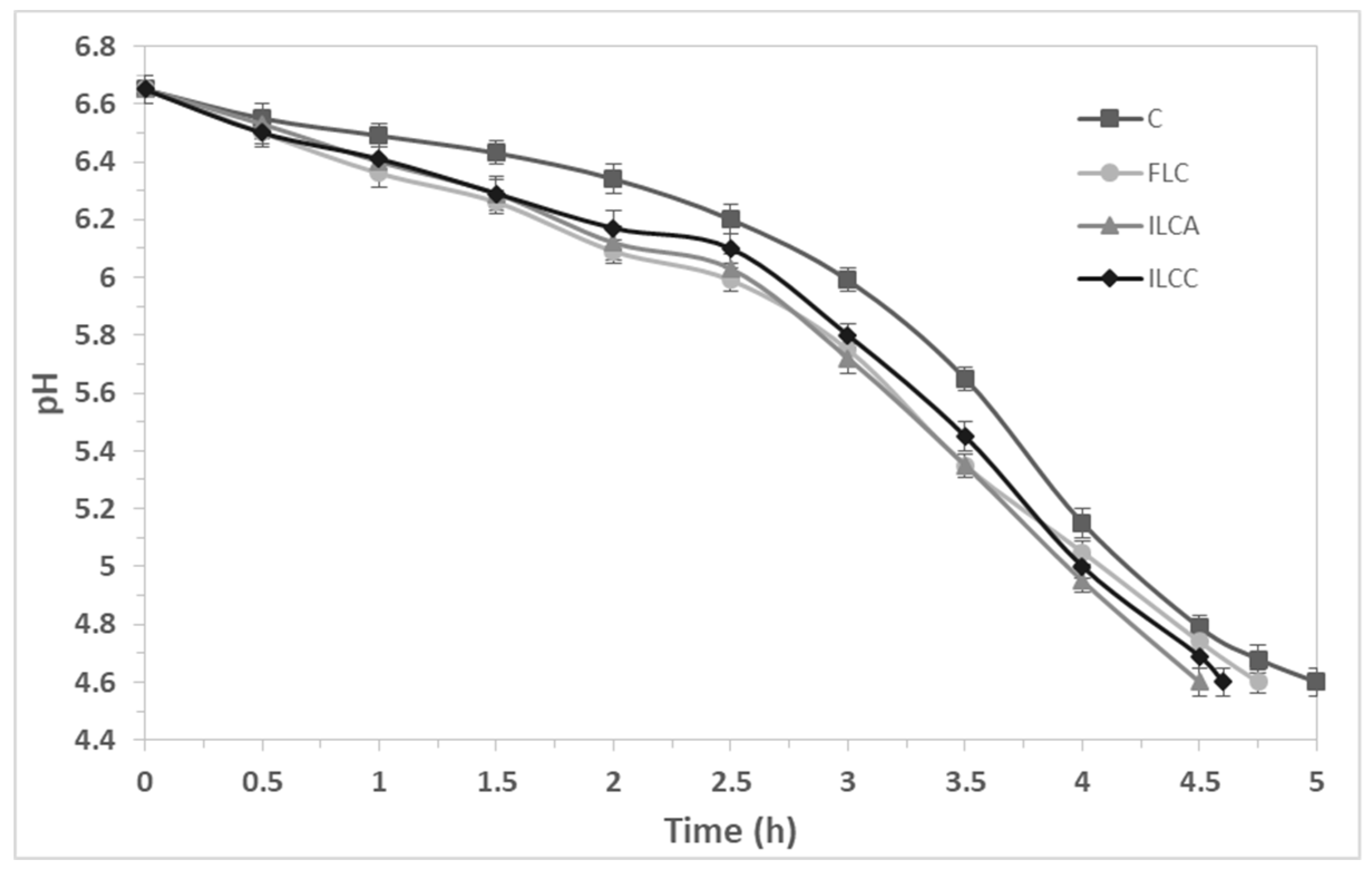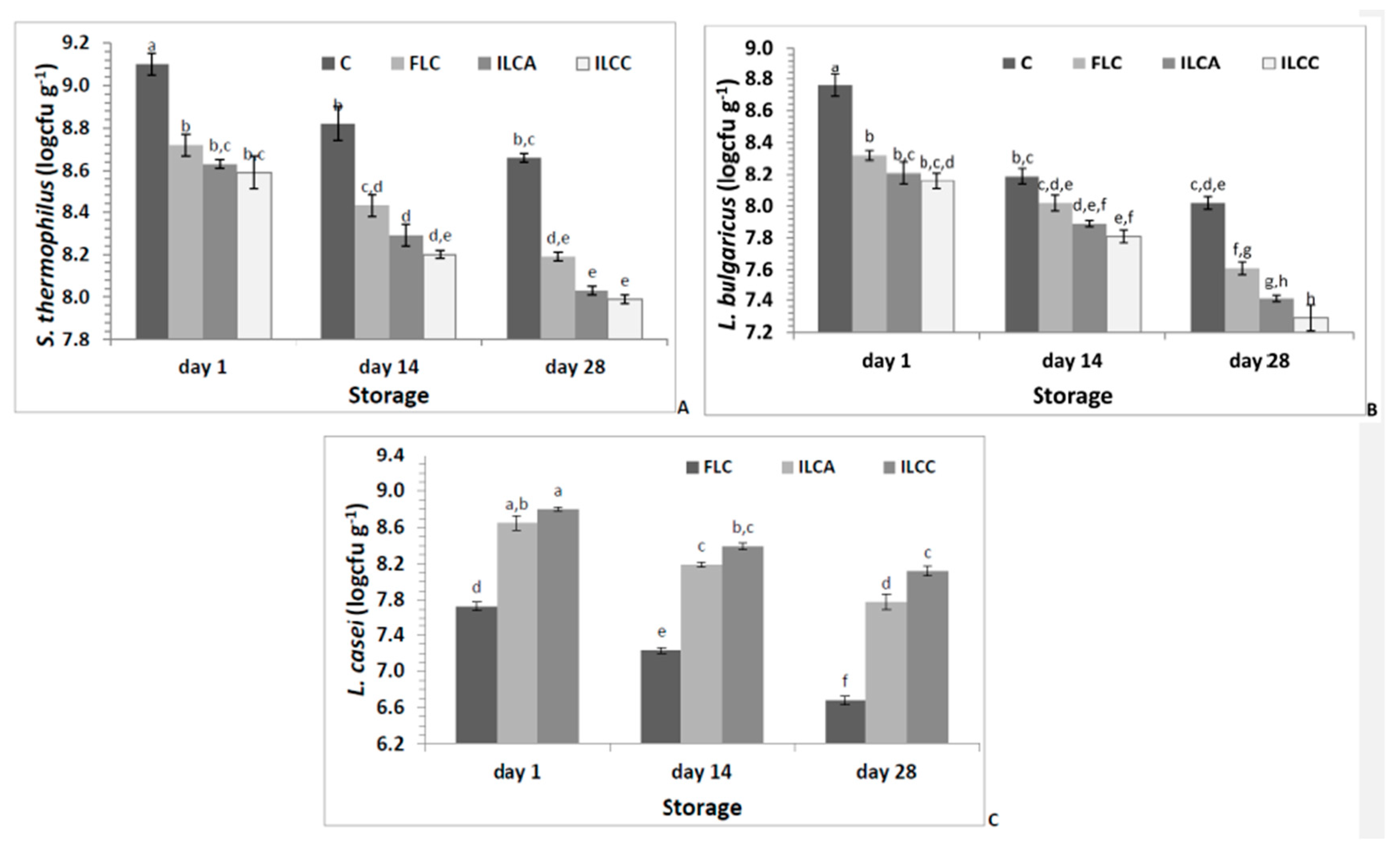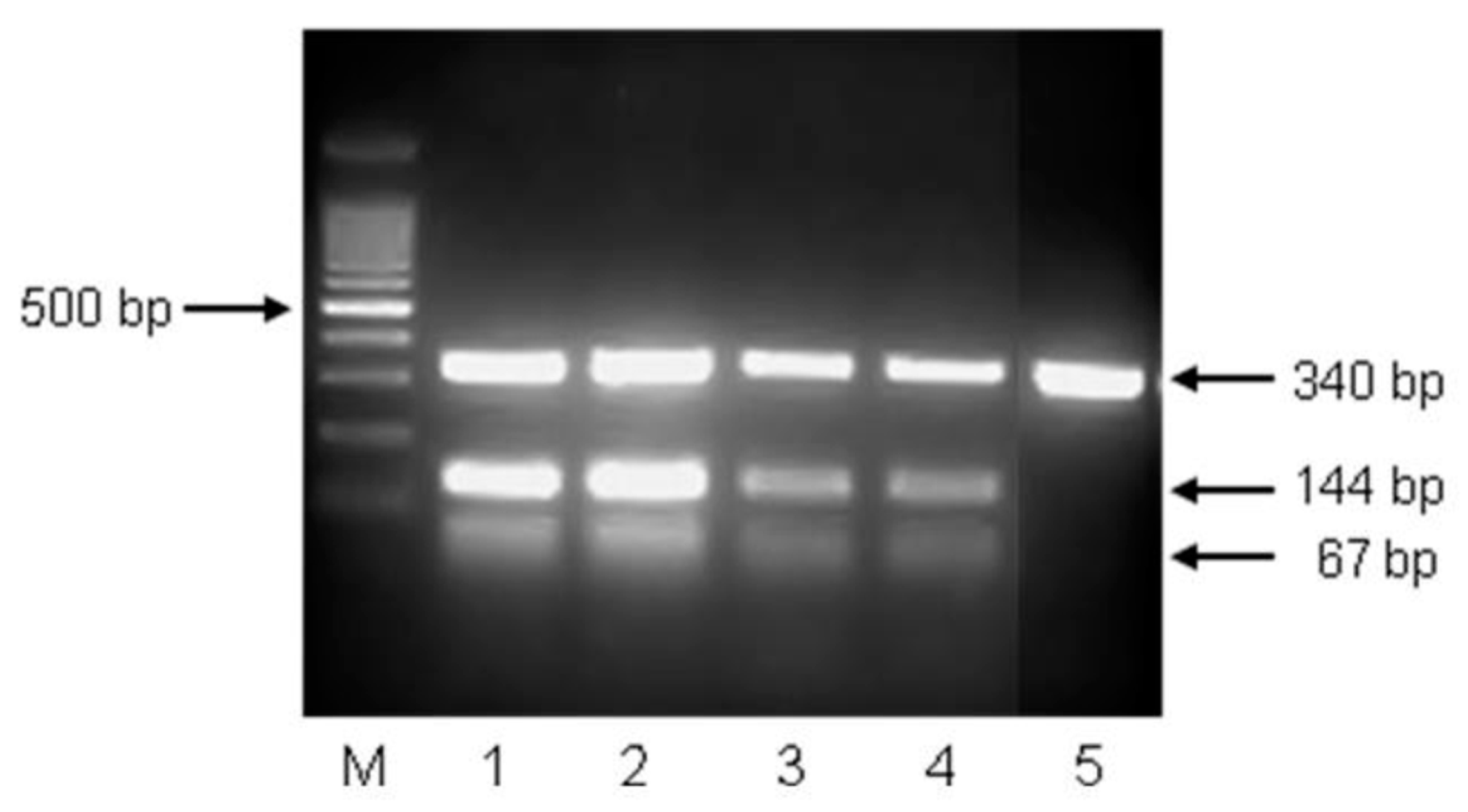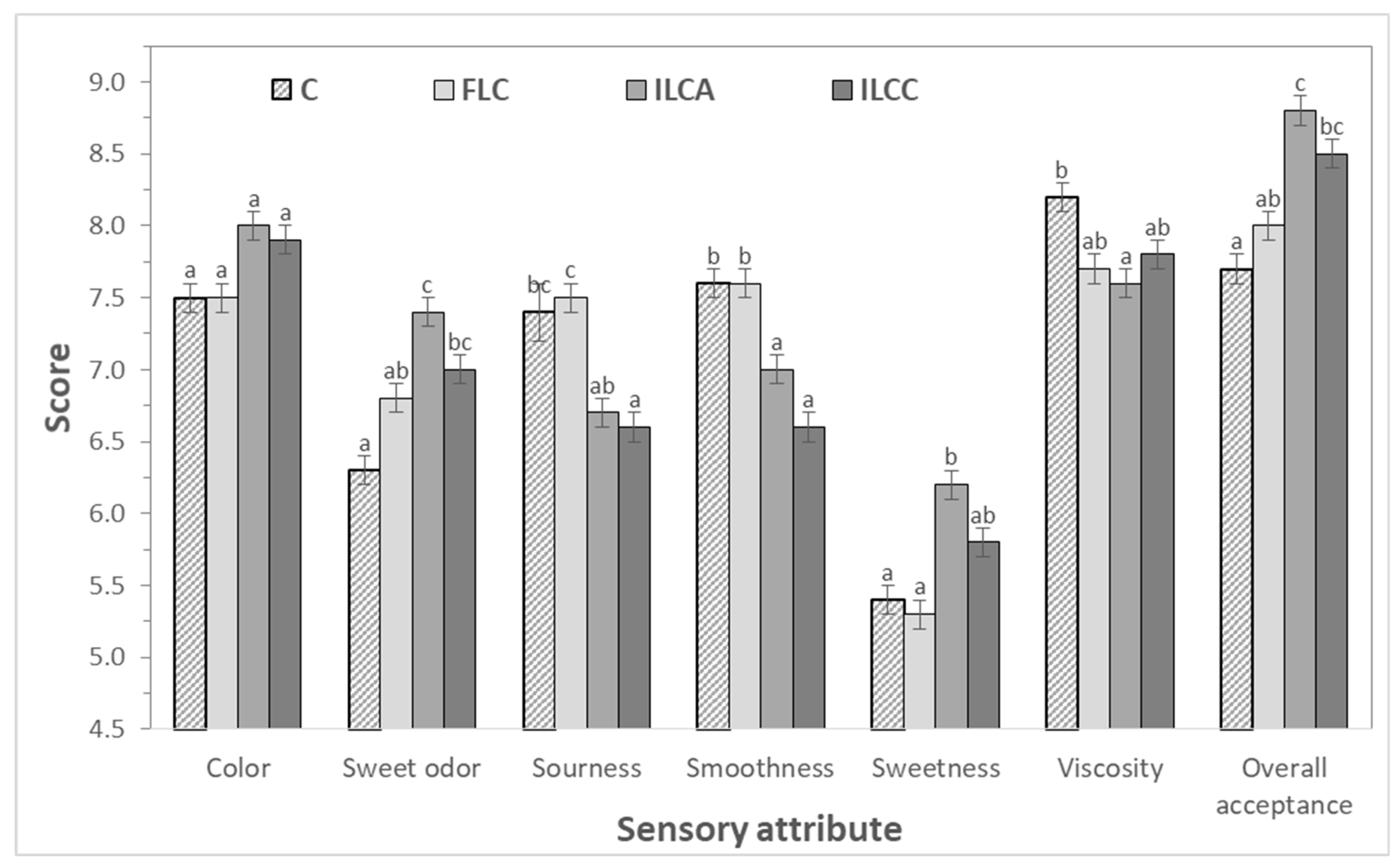Assessment of Freeze-Dried Immobilized Lactobacillus casei as Probiotic Adjunct Culture in Yogurts
Abstract
1. Introduction
2. Materials and Methods
2.1. Strains
2.2. Immobilization of L. casei
2.3. Freeze Drying of Free and Immobilized L. casei Cells
2.4. Yogurt Production
2.5. Determination of Cell Viability
2.5.1. Determination of S. thermophilus, L. bulgaricus, and L. casei Viability
2.5.2. Determination of L. casei ATCC 393 Levels
2.6. Physicochemical Analysis
2.6.1. pH and Titratable Acidity of Yogurts
2.6.2. Susceptibility to Syneresis and Water Holding Capacity
2.7. Solid-Phase Microextraction GC-MS Analysis
2.8. Sensory Evaluation of Yogurts
2.9. Statistical Analysis
3. Results and Discussion
3.1. Production of Novel Probiotic Yogurts with Immobilized L. casei ATCC 393
3.2. Physicochemical Characteristics of Novel Probiotic Yogurts
3.3. Microbiological Analysis of Novel Probiotic Yogurts
3.4. Aroma-Related Compounds of Novel Probiotic Yogurts
3.4.1. Esters
3.4.2. Organic Acids
3.4.3. Alcohols
3.4.4. Aldehydes
3.4.5. Ketones
3.4.6. Lactones
3.4.7. Total Volatile Compounds
3.5. Preliminary Sensory Evaluation of Novel Probiotic Yogurts
4. Conclusions
Author Contributions
Funding
Conflicts of Interest
References
- Prasanna, P.H.P.; Ranadheera, C.S.; Vidanarachchi, J.K. Microstructural aspects of yogurt and fermented milk. In Microstructure of Dairy Products; El-Bakry, M.M.A.R., Sanchez, A., Mehta, B.M., Eds.; John Wiley & Sons: Hoboken, NJ, USA, 2018; pp. 181–208. [Google Scholar]
- Sidira, M.; Karapetsas, A.; Galanis, A.; Kanellaki, M.; Kourkoutas, Y. Effective survival of immobilized Lactobacillus casei during ripening and heat treatment of probiotic dry-fermented sausages and investigation of the microbial dynamics. Meat Sci. 2014, 96, 948–955. [Google Scholar] [CrossRef] [PubMed]
- Sidira, M.; Santarmaki, V.; Kiourtzidis, M.; Argyri, A.A.; Papadopoulou, O.S.; Chorianopoulos, N.; Tassou, C.; Kaloutsas, S.; Galanis, A.; Kourkoutas, Y. Evaluation of immobilized Lactobacillus plantarum 2035 on whey protein as adjunct probiotic culture in yoghurt production. LWT-Food Sci. Technol. 2017, 75, 137–146. [Google Scholar] [CrossRef]
- Aryana, K.J.; Olson, D.W. A 100-Year Review: Yogurt and other cultured dairy products. J. Dairy Sci. 2017, 100, 9987–10013. [Google Scholar] [CrossRef] [PubMed]
- Mani-López, E.; Palou, E.; López-Malo, A. Probiotic viability and storage stability of yogurts and fermented milks prepared with several mixtures of lactic acid bacteria. J. Dairy Sci. 2014, 97, 2578–2590. [Google Scholar] [CrossRef] [PubMed]
- Abdel-Hamid, M.; Romeih, E.; Gamba, R.R.; Nagai, E.; Suzuki, T.; Koyanagi, T.; Enomoto, T. The biological activity of fermented milk produced by Lactobacillus casei ATCC 393 during cold storage. Int. Dairy J. 2019, 91, 1–8. [Google Scholar] [CrossRef]
- Marinaki, E.; Kandylis, P.; Dimitrellou, D.; Zakynthinos, G.; Varzakas, T. Probiotic yogurt production with Lactobacillus casei and prebiotics. Curr. Res. Nutr. Food Sci. 2016, 4, 48–53. [Google Scholar] [CrossRef]
- Sidira, M.; Dimitrellou, D.; Kanellaki, M.; Kourkoutas, Y. Volatile compounds of probiotic fermented sausages produced using immobilized L. casei on wheat. In Recent Advances in Food and Flavor Chemistry. Food Flavors and Encapsulation, Health Benefits, Analytical Methods and Molecular Biology of Functional Foods; Ho, C.T., Mussinan, C.J., Shahidi, F., Tratras Contis, E., Eds.; RSC Publishing: Cambridge, UK, 2010; pp. 178–184. [Google Scholar]
- Dimitrellou, D.; Kandylis, P.; Petrović, T.; Dimitrijević-Branković, S.; Lević, S.; Nedović, V.; Kourkoutas, Y. Survival of spray dried microencapsulated Lactobacillus casei ATCC 393 in simulated gastrointestinal conditions and fermented milk. LWT-Food Sci. Technol. 2016, 71, 169–174. [Google Scholar] [CrossRef]
- Sidira, M.; Galanis, A.; Ypsilantis, P.; Karapetsas, A.; Progaki, Z.; Simopoulos, C.; Kourkoutas, Y. Effect of probiotic-fermented milk administration on gastrointestinal survival of Lactobacillus casei ATCC 393 and modulation of intestinal microbial flora. J. Mol. Microbiol. Biotechnol. 2010, 19, 224–230. [Google Scholar] [CrossRef]
- Tiptiri-Kourpeti, A.; Spyridopoulou, K.; Santarmaki, V.; Aindelis, G.; Tompoulidou, E.; Lamprianidou, E.E.; Saxami, G.; Ypsilantis, P.; Lampri, E.S.; Simopoulos, C.; et al. Lactobacillus casei exerts anti-proliferative effects accmpanied by apoptotic cell death and up-regulation of TRAIL in colon carcinoma cells. PLoS ONE 2016, 11, e0147960. [Google Scholar] [CrossRef]
- Choi, S.S.; Kim, Y.; Han, K.S.; You, S.; Oh, S.; Kim, S.H. Effects of Lactobacillus strains on cancer cell proliferation and oxidative stress in vitro. Lett. Appl. Microbiol. 2006, 42, 452–458. [Google Scholar] [CrossRef]
- Dimitrellou, D.; Kandylis, P.; Kourkoutas, Y. Effect of cooling rate, freeze-drying, and storage on survival of free and immobilized Lactobacillus casei ATCC 393. LWT-Food Sci. Technol. 2016, 69, 468–473. [Google Scholar] [CrossRef]
- Dimitrellou, D.; Kourkoutas, Y.; Koutinas, A.A.; Kanellaki, M. Thermally-dried immobilized kefir on casein as starter culture in dried whey cheese production. Food Microbiol. 2009, 26, 809–820. [Google Scholar] [CrossRef] [PubMed]
- Dimitrellou, D.; Kandylis, P.; Kourkoutas, Y.; Koutinas, A.A.; Kanellaki, M. Cheese production using kefir culture entrapped in milk proteins. Appl. Biochem. Biotechnol. 2015, 176, 213–230. [Google Scholar] [CrossRef] [PubMed]
- Dimitrellou, D.; Kandylis, P.; Kourkoutas, Y.; Kanellaki, M. Novel probiotic whey cheese with immobilized lactobacilli on casein. LWT-Food Sci. Technol. 2017, 86, 627–634. [Google Scholar] [CrossRef]
- Khanizadeh, S.; Tsao, R.; Rekika, D.; Yang, R.; Charles, M.T.; Rupasinghe, H.V. Polyphenol composition and total antioxidant capacity of selected apple genotypes for processing. J. Food Compos. Anal. 2008, 21, 396–401. [Google Scholar] [CrossRef]
- Gorinstein, S.; Zachwieja, Z.; Folta, M.; Barton, H.; Piotrowicz, J.; Zemser, M.; Weisz, M.; Trakhtenberg, S.; Màrtín-Belloso, O. Comparative contents of dietary fiber, total phenolics, and minerals in persimmons and apples. J. Agric. Food Chem. 2001, 49, 952–957. [Google Scholar] [CrossRef] [PubMed]
- Park, J.; Floch, M.H. Prebiotics, probiotics, and dietary fiber in gastrointestinal disease. Gastroenterol. Clin. N. Am. 2007, 36, 47–63. [Google Scholar] [CrossRef]
- Do Espírito Santo, A.P.; Perego, P.; Converti, A.; Oliveira, M.N. Influence of food matrices on probiotic viability–A review focusing on the fruity bases. Trends Food Sci. Technol. 2011, 22, 377–385. [Google Scholar] [CrossRef]
- Rodrigues, S.; Silva, L.C.; Mulet, A.; Cárcel, J.A.; Fernandes, F.A. Development of dried probiotic apple cubes incorporated with Lactobacillus casei NRRL B-442. J. Funct. Foods 2018, 41, 48–54. [Google Scholar] [CrossRef]
- Corbo, M.R.; Bevilacqua, A.; Gallo, M.; Speranza, B.; Sinigaglia, M. Immobilization and microencapsulation of Lactobacillus plantarum: Performances and in vivo applications. Innov. Food Sci. Emerg. Technol. 2013, 18, 196–201. [Google Scholar] [CrossRef]
- Karapetsas, A.; Vavoulidis, E.; Galanis, A.; Sandaltzopoulos, R.; Kourkoutas, Y. Rapid detection and identification of probiotic Lactobacillus casei ATCC 393 by multiplex PCR. J. Mol. Microbiol. Biotechnol. 2010, 18, 156–161. [Google Scholar] [CrossRef] [PubMed]
- Tian, H.; Shen, Y.; Yu, H.; He, Y.; Chen, C. Effects of 4 probiotic strains in coculture with traditional starters on the flavor profile of yogurt. J. Food Sci. 2017, 82, 1693–1701. [Google Scholar] [CrossRef] [PubMed]
- Kailasapathy, K.; Harmstorf, I.; Phillips, M. Survival of Lactobacillus acidophilus and Bifidobacterium animalis ssp. lactis in stirred fruit yogurts. LWT-Food Sci. Technol. 2008, 41, 1317–1322. [Google Scholar] [CrossRef]
- Gurkan, H.; Hayaloglu, A.A. Volatiles and sensory characteristics of yogurt manufactured by incorporating basil (Ocimum basilicum L.). Int. J. Food Prop. 2017, 20, S779–S789. [Google Scholar] [CrossRef]
- Korbekandi, H.; Jahadi, M.; Maracy, M.; Abedi, D.; Jalali, M. Production and evaluation of a probiotic yogurt using Lactobacillus casei ssp. casei. Int. J. Dairy Technol. 2008, 62, 75–79. [Google Scholar] [CrossRef]
- Dave, R.I.; Shah, N.P. Viability of yoghurt and probiotic bacteria in yoghurts made from commercial starter cultures. Int. Dairy J. 1997, 7, 31–41. [Google Scholar] [CrossRef]
- Zhang, J.; Wu, C.; Du, G.; Chen, J. Enhanced acid tolerance in Lactobacillus casei by adaptive evolution and compared stress response during acid stress. Biotechnol. Bioprocess Eng. 2012, 17, 283–289. [Google Scholar] [CrossRef]
- Lucey, J.A.; Singh, H. Formation and physical properties of acid milk gels: A review. Food Res. Int. 1997, 30, 529–542. [Google Scholar] [CrossRef]
- Van Vliet, T.; Lucey, J.A.; Grolle, K.; Walstra, P. Food colloids. In Proteins, Lipids and Polysaccharides; Dickinson, E., Bergenstahl, B., Eds.; Royal Society of Chemistry: Cambridge, UK, 1997; pp. 335–345. [Google Scholar]
- Erkmen, O.; Bozoglu, T.F. Food Microbiology: Principles into Practice, Volume 2: Microorganisms in Food Preservation and Processing; John Wiley & Sons: Hoboken, NJ, USA, 2016; pp. 390–391. [Google Scholar]
- Kearney, N.; Stack, H.M.; Tobin, J.T.; Chaurin, V.; Fenelon, M.A.; Fitzgerald, G.F.; Ross, P.R.; Stanton, C. Lactobacillus paracasei NFBC 338 producing recombinant beta-glucan positively influences the functional properties of yoghurt. Int. Dairy J. 2011, 21, 561–567. [Google Scholar] [CrossRef]
- Zaręba, D.; Ziarno, M.; Ścibisz, I.; Gawron, J. The importance of volatile compound profile in the assessment of fermentation conducted by Lactobacillus casei DN-114 001. Int. Dairy J. 2014, 35, 11–14. [Google Scholar] [CrossRef]
- FAO/WHO. Codex Standard for Fermented Milks 243. In Codex Alimentarius Commission: Milk and Milk Products, 2nd Ed. ed; CODEX STAN 243-2003; World Health Organization & Food and Agriculture Organization of the United Nations: Rome, Italy, 2011; pp. 6–16. [Google Scholar]
- Tripathi, M.K.; Giri, S.K. Probiotic functional foods: Survival of probiotics during processing and storage. J. Funct. Foods 2014, 9, 225–241. [Google Scholar] [CrossRef]
- Knorr, D. Technology aspects related to microorganisms in functional foods. Trends Food Sci. Technol. 1998, 9, 295–306. [Google Scholar] [CrossRef]
- Chen, C.; Zhao, S.; Hao, G.; Yu, H.; Tian, H.; Zhao, G. Role of lactic acid bacteria on the yogurt flavour: A review. Int. J. Food Prop. 2017, 20, S316–S330. [Google Scholar] [CrossRef]
- Cheng, H. Volatile flavor compounds in yogurt: A review. Crit. Rev. Food Sci. Nutr. 2010, 50, 938–950. [Google Scholar] [CrossRef] [PubMed]
- Molimard, P.; Spinnler, H.E. Review: Compounds involved in the flavor of surface mold-ripened cheeses: Origins and properties. J. Dairy Sci. 1996, 79, 169–184. [Google Scholar] [CrossRef]
- Dan, T.; Wang, D.; Wu, S.; Jin, R.; Ren, W.; Sun, T. Profiles of volatile flavor compounds in milk fermented with different proportional combinations of Lactobacillus delbrueckii subsp. bulgaricus and Streptococcus thermophilus. Molecules 2017, 22, 1633. [Google Scholar] [CrossRef]
- Dimitrellou, D.; Kandylis, P.; Sidira, M.; Koutinas, A.A.; Kourkoutas, Y. Free and immobilized Lactobacillus casei ATCC 393 on whey protein as starter cultures for probiotic Feta-type cheese production. J. Dairy Sci. 2014, 97, 4675–4685. [Google Scholar] [CrossRef] [PubMed]
- Bianchi, F.; Careri, M.; Mangia, A.; Musci, M. Retention indices in the analysis of food aroma volatile compounds in temperature-programmed gas chromatography: Database creation and evaluation of precision and robustness. J. Sep. Sci. 2007, 30, 563–572. [Google Scholar] [CrossRef]
- Zourari, A.; Accolas, J.P.; Desmazeaud, M.J. Metabolism and biochemical characteristics of yogurt bacteria. A review. Le Lait 1992, 72, 1–34. [Google Scholar] [CrossRef]
- Güler, Z.; Taşdelen, A.; Şenol, H.; Kerimoğlu, N.; Temel, U. The determination of volatile compounds in set-type yogurts using static headspace gas chromatographic method. GIDA J. Food 2009, 34, 137–142. [Google Scholar]
- Guler, Z. Changes in salted yoghurt during storage. Int. J. Food Sci. Technol. 2007, 42, 235–245. [Google Scholar] [CrossRef]
- Gallardo-Escamilla, F.J.; Kelly, A.L.; Delahunty, C.M. Influence of starter culture on flavor and headspace volatile profiles of fermented whey and whey produced from fermented milk. J. Dairy Sci. 2005, 88, 3745–3753. [Google Scholar] [CrossRef]
- Sidira, M.; Saxami, G.; Dimitrellou, D.; Santarmaki, V.; Galanis, A.; Kourkoutas, Y. Monitoring survival of Lactobacillus casei ATCC 393 in probiotic yogurts using an efficient molecular tool. J. Dairy Sci. 2013, 96, 3369–3377. [Google Scholar] [CrossRef] [PubMed]




| Analysis | Storage (Days) | Yogurt 1 | |||
|---|---|---|---|---|---|
| C | FLC | ILCA | ILCC | ||
| pH | 1 | 4.55 ± 0.05 a | 4.50 ± 0.03 a | 4.52 ± 0.05 a | 4.51 ± 0.02 a |
| 7 | 4.46 ± 0.04 ab | 4.37 ± 0.01 b | 4.39 ± 0.02 ab | 4.42 ± 0.03 a | |
| 14 | 4.32 ± 0.02 b,XY | 4.35 ± 0.02 bc,X | 4.30 ± 0.03 bc,XY | 4.20 ± 0.01 b,Y | |
| 21 | 4.30 ± 0.03 b,X | 4.22 ± 0.02 cd,XY | 4.20 ± 0.01 cd,XY | 4.18 ± 0.01 b,Y | |
| 28 | 4.29 ± 0.02 b,X | 4.12 ± 0.04 d,Y | 4.04 ± 0.02 d,YZ | 3.92 ± 0.02 c,Z | |
| Acidity (g lactic acid/100 g yogurt) | 1 | 0.75 ± 0.01 | 0.72 ± 0.02 b | 0.75 ± 0.03 b | 0.76 ± 0.02 c |
| 7 | 0.76 ± 0.02 | 0.79 ± 0.01 ab | 0.78 ± 0.02 b | 0.84 ± 0.02 bc | |
| 14 | 0.80 ± 0.01 Y | 0.81 ± 0.01 ab,Y | 0.81 ± 0.02 b,Y | 0.89 ± 0.01 b,X | |
| 21 | 0.82 ± 0.02 Y | 0.87 ± 0.02 a,Y | 1.03 ± 0.01 a,X | 1.02 ± 0.02 a,X | |
| 28 | 0.83 ± 0.02 Y | 0.88 ± 0.02 a,Y | 1.04 ± 0.01 a,X | 1.10 ± 0.03 a,X | |
| STS (%) | 1 | 42.0 ± 0.5 X | 37.8 ± 0.2 a,Y | 36.7 ± 0.3 a,Y | 35.5 ± 0.9 a,Y |
| 7 | 42.3 ± 0.7 X | 39.8 ± 0.1 b,XY | 38.2 ± 0.5 ab,Y | 37.2 ± 0.5 ab,Y | |
| 14 | 43.6 ± 0.5 X | 41.2 ± 0.5 bc,XY | 39.3 ± 0.4 bc,Y | 38.3 ± 0.7 abc,Y | |
| 21 | 43.5 ± 0.6 X | 42.9 ± 0.4 c,X | 40.1 ± 0.4 bc,Y | 39.6 ± 0.5 bc,Y | |
| 28 | 44.1 ± 0.4 X | 42.6 ± 0.4 c,XY | 40.8 ± 0.2 c,Y | 41.0 ± 0.3 c,Y | |
| Compound | Identification Method 1 | Yogurt 2 | |||
|---|---|---|---|---|---|
| C | FLC | ILCA | ILCC | ||
| Esters | |||||
| Ethyl butanoate | RT, KI, MS | 1.2 ± 0.2 a | 0.4 ± 0.1 b | 0.5 ± 0.1 ab | ND |
| Ethyl hexanoate | RT, KI, MS | 0.8 ± 0.2 a | ND | ND | 0.2 ± 0.2 a |
| Ethyl octanoate | RT, KI, MS | ND 3 | 0.7 ± 0.2 a | 0.9 ± 0.3 a | ND |
| Ethyl decanoate | RT, KI, MS | ND | ND | 1.0 ± 0.2 a | 0.7 ± 0.3 a |
| Organic acids | |||||
| Acetic acid | MS | 25.3 ± 1.2 a | 31.4 ± 2.1 a | 52.4 ± 3.0 b | 51.2 ± 2.9 b |
| Butanoic acid | KI, MS | 19.2 ± 2.1 a | 41.4 ± 3.9 b | 37.7 ± 3.1 b | 40.5 ± 1.5 b |
| Hexanoic acid | KI, MS | 47.6 ± 3.0 a | 71.5 ± 4.5 b | 82.1 ± 5.0 b | 78.7 ± 3.6 b |
| Octanoic acid | RT, KI, MS | 59.2 ± 3.5 a | 30.9 ± 2.1 b | 41.5 ± 3.0 b | 35.4 ± 1.5 b |
| Nonanoic acid | RT, KI, MS | 9.3 ± 0.9 ab | 7.2 ± 0.5 a | 10.2 ± 0.8 ab | 13.4 ± 0.9 b |
| Decanoic acid | RT, KI, MS | 37.4 ± 2.2 a | 56.5 ± 4.2 ab | 65.1 ± 3.2 b | 70.2 ± 4.3 b |
| 2-Methyl butanoic acid | KI, MS | ND | ND | ND | 4.2 ± 0.9 |
| Alcohols | |||||
| Ethanol | RT, KI, MS | >10,000 | >10,000 | >10,000 | >10,000 |
| 1-Hexanol | RT, KI, MS | 4.2 ± 1.0 a | ND | ND | 3.1 ± 0.4 a |
| 1-Heptanol | KI, MS | 5.1 ± 0.8 a | 2.1 ± 0.5 b | ND | ND |
| 1-Octanol | RT, KI, MS | ND | ND | 1.2 ± 0.6 a | 0.7 ± 0.2 a |
| 1-Nonanol | RT, KI, MS | 2.0 ± 0.5 a | ND | ND | 0.4 ± 0.2 b |
| 3-Methyl-1-butanol | RT, KI, MS | ND | 0.7 ± 0.3 a | 0.4 ± 0.2 a | ND |
| 2-Heptanol | RT, KI, MS | ND | ND | 1.2 ± 0.4 | ND |
| 2-Nonanol | RT, KI, MS | 1.2 ± 0.6 c | 2.9 ± 0.5 bc | 5.1 ± 0.8 a | 4.0 ± 1.0 ab |
| 1-Octen-3-ol | RT, KI, MS | 2.7 ± 0.4 a | ND | 1.2 ± 0.2 b | ND |
| 2-Ethyl-1-hexanol | RT, KI, MS | 3.1 ± 0.3 a | 12.4 ± 1.0 b | 16.1 ± 1.2 b | 18.7 ± 1.6 b |
| Phenyl ethanol | RT, KI, MS | ND | 0.9 ± 0.3 | ND | ND |
| Aldehydes | |||||
| Acetaldehyde | KI, MS | 17.3 ± 1.0 a | 16.7 ± 1.2 a | 18.4 ± 0.5 a | 17.9 ± 1.0 a |
| 3-Methyl butanal | KI, MS | 0.8 ± 0.2 a | 1.2 ± 0.5 a | 1.5 ± 0.2 a | 1.9 ± 0.2 a |
| Hexanal | KI, MS | ND | 2.1 ± 0.4 a | ND | 2.8 ± 0.3 a |
| Heptanal | KI, MS | 2.1 ± 0.4 a | 3.5 ± 0.3 ab | 4.7 ± 0.9 ab | 5.1 ± 0.3 b |
| Octanal | KI, MS | 5.1 ± 0.5 a | 12.1 ± 1.0 b | 12.8 ± 1.0 b | 14.1 ± 0.9 b |
| Nonanal | KI, MS | 9.5 ± 0.6 a | 10.5 ± 0.5 a | 14.2 ± 1.1 ab | 16.7 ± 1.2 b |
| (E,E)-2,4-Heptanedial | KI, MS | ND | 5.6 ± 0.4 a | 10.2 ± 0.8 b | 12.1 ± 0.8 b |
| (E)-2-Nonenal | KI, MS | 5.9 ± 0.4 a | 4.1 ± 0.1 ab | 7.3 ± 0.5 b | 6.7 ± 0.4 b |
| Ketones | |||||
| Acetone | KI, MS | 15.1 ± 0.8 a | 12.9 ± 1.0 a | 13.1 ± 1.2 a | 11.5 ± 0.5 a |
| 2-Butanone | KI, MS | 27.3 ± 1.5 a | 69.4 ± 2.3 b | 102.1 ± 9.5 b | 100.9 ± 10.8b |
| 2-Pentanone | MS | 19.7 ± 1.0 a | 47.3 ± 2.0 b | 82.4 ± 5.5 c | 80.1 ± 7.0 c |
| 2-Heptanone | KI, MS | 22.4 ± 2.3 a | 51.2 ± 1.8 b | 81.7 ± 4.9 c | 92.4 ± 6.4 c |
| 2-Octanone | MS | 12.1 ± 1.1 a | 21.3 ± 1.2 b | 29.4 ± 2.2 b | 27.3 ± 1.2 b |
| 2-Nonanone | KI, MS | 13.9 ± 1.0 a | 15.2 ± 1.5 a | 19.4 ± 1.1 a | 17.3 ± 0.9 a |
| 2-Undecanone | KI, MS | 4.9 ± 0.5 a | 12.3 ± 0.8 b | 11.9 ± 0.8 b | 15.4 ± 1.0 b |
| 2-Tridecanone | MS | ND | 17.4 ± 0.7 a | 21.5 ± 1.0 a | 20.4 ± 1.5 a |
| 3-Hydroxy-2-butanone(acetoin) | KI, MS | 73.1 ± 5.5 a | 98.2 ± 7.8 ab | 143.2 ± 11.0 bc | 159.2 ± 13.8 c |
| 2,3-Butanedione(diacetyl) | MS | 27.4 ± 1.5 a | 29.3 ± 2.2 a | 32.1 ± 3.0 a | 33.1 ± 1.2 a |
| 2,3-Pentanedione | MS | 5.2 ± 2.0 a | 10.1 ± 1.5 b | 7.9 ± 1.0 ab | 8.7 ± 0.9 b |
| Lactones | |||||
| γ-Dodecalactone | KI, MS | ND | 1.2 ± 0.8 | ND | ND |
| δ-Dodecalactone | KI, MS | 0.5 ± 0.2 a | 5.1 ± 0.8 b | 4.9 ± 0.7 b | 6.2 ± 0.4 b |
| Total compounds | |||||
| Esters | 2.0 ± 0.4 a | 1.1 ± 0.3 a | 2.4 ± 0.6 a | 0.9 ± 0.5 a | |
| Organic Acids | 198.0 ± 12.9 a | 238.9 ± 17.3 ab | 289.0 ± 18.1 ab | 293.6 ± 15.6 b | |
| Alcohols | 18.3 ± 3.6 | 19.0 ± 2.6 | 25.2 ± 3.0 | 26.9 ± 3.4 | |
| Aldehydes | 40.7 ± 3.1 a | 55.8 ± 4.2 ab | 69.1 ± 5.0 b | 77.3 ± 5.1 b | |
| Ketones | 220.6 ± 14.7 a | 385.1 ± 22.3 ab | 544.7 ± 39.2 b | 566.3 ± 45.2 b | |
| Lactones | 0.5 ± 0.2 a | 6.3 ± 1.6 b | 4.9 ± 0.7 ab | 6.2 ± 0.4 b | |
| Total | 480.1 ± 34.9 a | 706.2 ± 48.3 ab | 935.3 ± 66.6 b | 971.2 ± 70.2 b | |
© 2019 by the authors. Licensee MDPI, Basel, Switzerland. This article is an open access article distributed under the terms and conditions of the Creative Commons Attribution (CC BY) license (http://creativecommons.org/licenses/by/4.0/).
Share and Cite
Dimitrellou, D.; Kandylis, P.; Kourkoutas, Y. Assessment of Freeze-Dried Immobilized Lactobacillus casei as Probiotic Adjunct Culture in Yogurts. Foods 2019, 8, 374. https://doi.org/10.3390/foods8090374
Dimitrellou D, Kandylis P, Kourkoutas Y. Assessment of Freeze-Dried Immobilized Lactobacillus casei as Probiotic Adjunct Culture in Yogurts. Foods. 2019; 8(9):374. https://doi.org/10.3390/foods8090374
Chicago/Turabian StyleDimitrellou, Dimitra, Panagiotis Kandylis, and Yiannis Kourkoutas. 2019. "Assessment of Freeze-Dried Immobilized Lactobacillus casei as Probiotic Adjunct Culture in Yogurts" Foods 8, no. 9: 374. https://doi.org/10.3390/foods8090374
APA StyleDimitrellou, D., Kandylis, P., & Kourkoutas, Y. (2019). Assessment of Freeze-Dried Immobilized Lactobacillus casei as Probiotic Adjunct Culture in Yogurts. Foods, 8(9), 374. https://doi.org/10.3390/foods8090374







